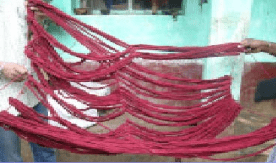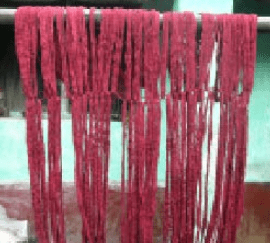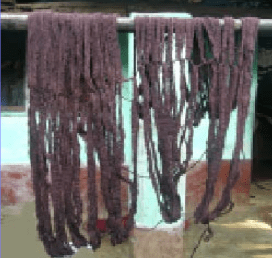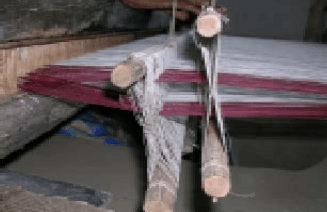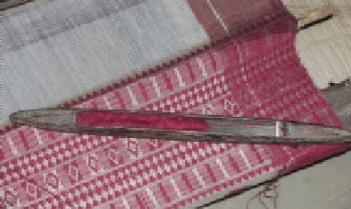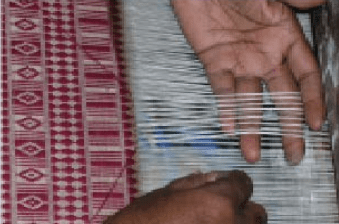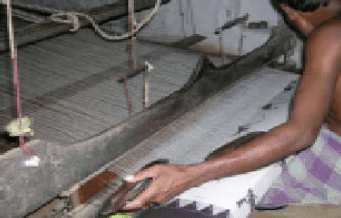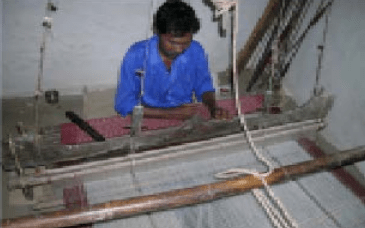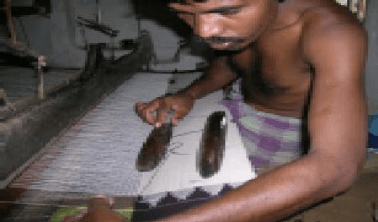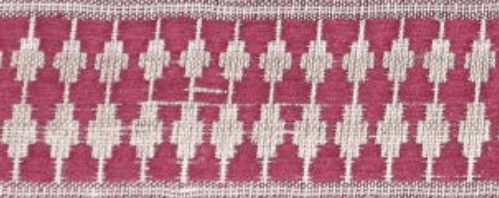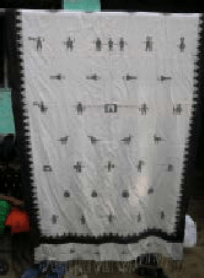Indian hand woven fabrics have been known since time immemorial. Poets of the Mughal Durbar likened our muslins to baft hawa (woven air), abe rawan(running water) and shabnam (morning dew).
There is a tale of Emperor Aurangzeb having a fit of rage one day, on seeing his daughter Princess Zeb-un-Nissa clad in almost nothing. On being severely rebuked, the princess explained that she had not one but seven jamahs (dresses) on her body. Such was the fineness of the hand woven fabrics.
Step by Step making of Koraput Weaving
Handlooms are an important craft product and comprise the largest cottage industry of the country. Millions of looms across the country are engaged in weaving cotton, silk and other natural fibers. There is hardly a village where weavers do not exist, each weaving out the traditional beauty of India’s precious heritage.
Orissa has one of the richest traditions of handloom and handicrafts in the country, which goes back to the time of antiquity. The art of weaving in the state is highly evolved and its fabrics bear testimony to the unique and artistic ability and tradition of the weavers of this state.
The tribal weave of Kotpad village in Koraput District is traditionally woven in heavy cotton ranging from counts of 10s to 20s. The use of natural dye extracted from the roots of the Indian Madder tree (aal tree) makes it different from other weaves. The weaver uses a three-shuttle interlock patterning, which allows for innumerable combinations in scale and volume.
DIFFERENCE BETWEEN SAMBALPURI AND KORAPUT WEAVE
In Sambalpuri weave the loom once set can be used to make 20-30 sarees of the same design. In Koraput weave only one saree of a particular type can be woven once the loom is set. Sambalpuri weaving is done using jacquard looms as well as pit looms; Koraput weave is only made on pit looms.
Producer communities
Panka is the main tribe engaged in the Koraput weave. Earlier weaving was more widespread. Since it is a time consuming activity without commensurate pay, many people are shifting from weaving to other occupations.
Some tribes, such as Gadaba, Dongaria khand and Bondo still weave and embellish their own textiles. Other tribes like Bathra, Bhumia and Tanti earn their bread and butter by farming and a few other crafts like terracotta, wrought iron, bamboo, tribal jewelry and paddy craft etc.
Craft tradition
The tradition of Koraput weave started with the few tribal people who used to weave their own clothes. Traditionally, they used to weave sarees which were narrower than the existing sarees, made of heavy thick unbleached cotton with a single color pattern woven in red, purple or brown. The yarn was dyed with natural dye made of the roots of Aal (Madder tree).
Raw material
Yarn
Yarn is a long continuous length of interlocked fibers, suitable for use in the production of textiles, sewing, knitting, weaving and rope making. Yarn can be made from any number of synthetic or natural fibers. Very thin yarn is referred to as thread. Yarns are made up of any number of plies, each ply being a single thread. These threads are twisted (plied) together to make the final yarn.
Two varieties of yarn are used:
Cotton yarn
Cotton yarn is purchased from Sambalpur District, Orissa.
The number of muda (rolls) of yarn in one peti depends on the count:
20 rolls of yarn of 20s count
40 rolls of 80s count
30 rolls of
60s count
Silk yarn
Tussar silk yarn is used. Silk yarn can be purchased from Jagdalpur, Rayagada District, and Orissa and from Sambalpur District, Orissa.
Aal ki chaal / Madder dye
The knowledge and use of vegetable and mineral dyes goes back to pre-historic times in India. According to data collected so far, there are nearly 300 dye-yielding plants available in the country.
However, after chemical colors flooded the markets, only a small number of dyers continued with natural dyes such as indigo. Cotton yarn dyed in madder is still used by the weavers of Kotpad in Koraput district. The characteristic natural dye coloring is derived from the aalor madder dye extracted from the root of Indian Madder tree.
The root of the Madder tree is bought from the tribes of the Kalahandi jungles.
Kumahar pathar / Iron
Kumahar pathar or loha pathar is sulphate of iron. This is locally available as waste with any blacksmith. The blacksmith gives the weavers kumahar patharin exchange for some goods or a little money. Kumahar pathar is crushed and brought to powder form by using this wooden grinder that is operated by foot.
•Castor oil
•Wood ash
Wood ash is used during the dyeing process of the cotton yarn.
•Cow dung
Cow dung is used while dyeing the cotton yarn. It acts as a bleaching agent. When applied to the yarn, it ensures that the dye is absorbed properly.
•Tora oil
It is used in the kangi. It acts as a lubricant for the yarn on the loom.
•Starch
Starch is applied on the yarn when it is stretched out before setting it on the loom. This is done to provide strength to the yarn and prevent it from breaking and tangling. Starch is made from flour and water.
PROCESSING OF THE RAW MATERIAL
Dyeing cotton yarn
The process of dyeing is very tedious. Dyeing is done mostly in winter. The most suitable time for dying is from November to March. The foremost requirement for dyeing is sunlight, without which the process cannot be completed.
First of all two mudas are tied as one with rope for convenience of handling the yarn reels. The yarn from the mill is washed thoroughly in cold water.
Castor oil is applied to the washed yarn. A solution of 5 liters castor oil and 5-6 liters of normal water is made. Thereafter, the yarn is either dipped in the solution or the solution is applied by hand to the yarn. Applying oil by hand is more effective, as the oil spreads evenly.
After the application of castor oil, cow dung is rubbed on the yarn. This is done to bleach the yarn, and ensure proper dyeing. The yarn is then kept for drying in the sun. Care should be taken while drying the yarn; the yarns fire up if they are placed on top of each other.
After the yarn has been left to dry for a day, it is rubbed down with a solution of wood ash boiled in water. This process is supposed to be done twice a day, once in the morning and once in the evening for around 15 days i.e. 30 times. Then the yarn is kept in the sun for drying.
Thereafter, the yarn treated with ash and water is washed thoroughly in the lake. With this the cow dung washes out properly, and the yarn becomes whitish in color.
For dyeing the yarn to a deep maroon color, a solution is prepared with 100 grams of castor oil, 1/2 kg powder of aal bark and 5 liters of luke-warm water. The yarn is immersed in this solution for a day. The next day, the yarn along with the solution is put to boil.
This is stirred continuously with a wooden stick and boiled till the entire solution dries up.
The powerful and vibrant colours ranging from deep maroon to dark brown depend on the age of the root bark and the proportion of dye used.
To dye the yarn in shades of brown, kumahar pathar is used. The stone is crushed and powdered. This powder is then mixed with jaggery and water and put aside for 4-5 days till the solution becomes black.
Thereafter, this solution is mixed with the ingredients used earlier for deep maroon color i.e. 100 grams of castor oil, 1/2 kg powder of aal bark and 5 liters of luke-warm water. The yarn is boiled in this solution with continuous stirring, till the entire solution dries up.
After the dyeing is completed, yarn is left in the sun to dry. The dyeing process is done by women.
TOOLS
Pit Loom
The pit loom is a horizontal, ground – staked handloom at which the weaver sits in a pit dug below floor level. This type of loom saves space and lumber, and is typical of most village production in India today.
Bharni
The Bharni is a wooden frame. The yarn reel is fitted on this and then single threads are rolled on the Tossar. This helps individual threads of the yarn to separate from each other.
Tossar
This is a long wooden stick with a circular head. The yarn from the Bharni is wrapped on the Tossar so that it can be put in the shuttle.
Pawan /Warping Board
This a wooden frame used to separate cotton yarn and prepare it to be fitted in the warp. This is a device which is used to measure the thread that will be held under tension during weaving.
Purni
Purni is a hollow cylindrical pipe made out of bamboo. It is used to arrange the yarn on the Pawan from the Bharni for warping.
Kangi / Comb
This is the comb through which the warp passes.
Nathi / Spindle
This is a conical wooden frame, which is motioned in circles to wrap the separated threads of the silk yarn.
Chipana
These are flat wooden sticks, which are parted from the centre like tongs. They are used to hold the combed yarn together and prevent it from tangling.
Dongi/ Shuttle
The shuttle is a boat-shaped device containing a supply of weft thread on a spool. It travels through the shed from one side of the loom to the other, propelled either by the weaver’s hand or by a mechanical fly arm. There are two types of shuttles used for this weaving:
•Smaller shuttle for borders.
•Bigger shuttle for weaving the whole body of the saree.
PROCESS OF WEAVING
Warp making
The master weaver carries out the process of warp making depending upon the requirement of the design and color combination. Since the process requires a lot of space, the warp is made outside in the open. A taana (warp) machine is used.
The thread rolls are put on a movable vertical frame. The ends of the thread are passed through another small, grid like frame that guides the threads, and are wound on a cylinder in the desired combination.
This process starts from one end of the cylinder and goes on till the entire cylinder is covered with thread. Tora oil is applied on the threads, to make them move easily on the loom.
Once this is achieved, the log upon which the taana is to be wound is fitted into the blocks between the cylinder and the frame. The tightly wound thread on this log is then provided to the weaver who uses it on the loom.
Setting the loom
The first step in weaving is to stretch the lengthwise yarns that run from the back to the front of the loom. These form the basic structure of the fabric and are called the warp or longitudinal yarns, which must be very strong.
The weft, woof, or filling crosses the warp, binding the warp threads at either side to form the selvage (the edge of a fabric that is woven so that it will not ravel or fray).
The three essential steps after the warp is stretched are:
1. Shedding, or raising every alternate warp yarn or set of yarns to receive the weft;
2. Picking, or inserting the weft; and
3. Battening, or pressing home the weft to make the fabric compact. In most primitive weaving these operations were performed by the hands alone, as in making rush mats and baskets.
Gradually, frames for holding the warp evenly stretched, and devices for throwing the weft came into use.
On the loom, the warp beam is mounted at the back and the warp yarns are conveyed to a long wooden block or cylinder called the cloth roll, which is at the front of the loom and on which the fabric is rolled as it is constructed.
Supported on the loom frame between these two cylinders (the warp beam and the cloth beam), the warp yarns are ready to be interlaced by the filling yarns that run in the width of the cloth, thus producing the woven fabric. Men carry out the weaving process.
Washing the woven fabric
Once the entire fabric is woven,
Shikakai and Reetha are used for the first wash, which is a soft wash so as to make the color permanent and strong.
Motifs
The motifs and designs used in Koraput weave have been passed down from generation to generation. These motifs were woven and worn by tribes of this area, and are now used as basic designs of Koraput weave. While traditional motifs continue to be used, the products woven have changed from only the saree, to include other contemporary products.
Market
Koraput weaving originated in the clothes the tribes wove for their own use. Gradually they started weaving traditional short sarees for the local market also. These were sold in markets like Mangal bazaar, Jagdalpur etc. From about 1985 Koraput products began to get exposure outside local boundaries.
Government exhibitions and fairs helped Koraput weave develop an identity in national markets. Weavers started getting orders from Delhi, Hyderabad, Madras, Bhubane shwar etc. With the expansion of their markets weavers expanded their product range from short length sarees to full-length sarees, dress material, dupattas and kurtas. Incorporating new designs, the Koraput weave is now being exported to other countries as well.
Natural-dyed Koraput textiles face strong competition from chemically dyed products. Chemical dyeing is less labor intensive, and therefore has a price advantage.
Changes over the years
Technology
Kora put weaves are still made using age-old techniques of weaving and dyeing. There has been no change in technology; pit looms continue to be used for weaving.
Design
The designs used have an underlying symbolism and are largely inspired by nature. One distinctive motif is a pyramidal pattern called by weavers: the phool, cheeta, chauk which translates as ’flower, leopard, and seat’.
They also produce many discontinuous supplementary weft motifs placed in rows in the field such as leaves, snakes, axes and even some non-traditional items such as umbrellas and aero planes. The significant difference that has come in designing with the change in market conditions is that earlier they made bold tribal motifs but now minute and detailed work is favored. The weavers are now creating textiles with much finer counts and different widths to suit the urban markets.
Market
Earlier craftsmen only made Faltual,a traditional dress with tribal motifs and short length traditional sarees. As the demand for Koraput weaving grew in other markets like Delhi, Bangalore, Madras, and Hyderabad, the product range expanded to dress material, full-length sarees, dupattas etc. Now short kurtas of Koraput weave are also available in the market.
Products and their uses
Koraput weaving uses designs which have an underlying symbolism and are largely inspired by nature or by significant objects of daily use. The end use of the fabrics is mainly apparel. The product names are kept according to the designs applied on them.
They are:
Fultual
This is based on traditional designs is worn by the tribes of that village.
Sarees
Earlier, sarees woven were narrow: i.e. 42 inches in keeping with the traditional Orissa saree. With the expansion of markets outside Orissa, full-length sarees are also woven.
Patta
Patta is a traditional scarf with traditional motifs.
Dupattas
Dupattas are made out of cotton as well as tussar silk, woven in various sizes according to the prevailing market demand. The existing sizes are 27 inches, 22 inches and 16 inches in breadth.
Dress materials
Dress materials are available in cotton and tussar silk.
Short kurtas
With external design intervention, the weavers are making short kurtas of different styles.



